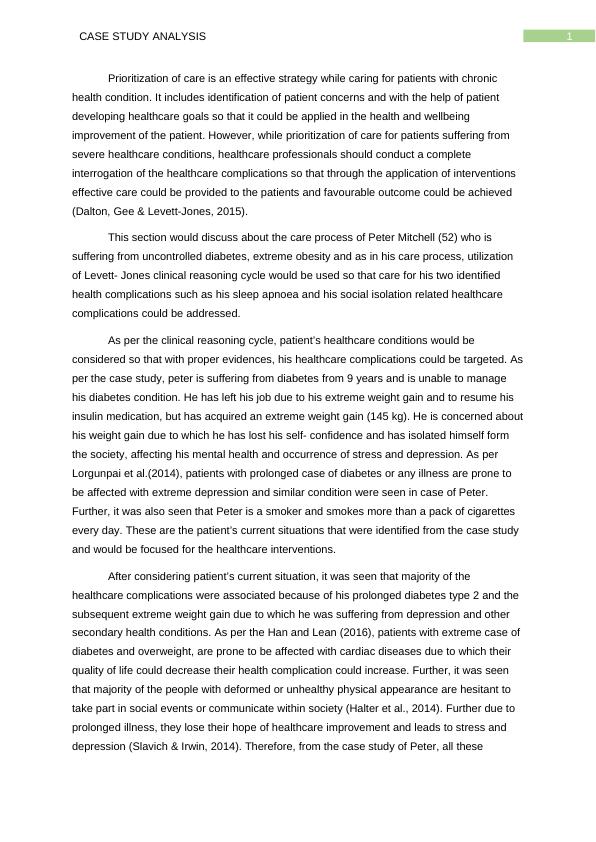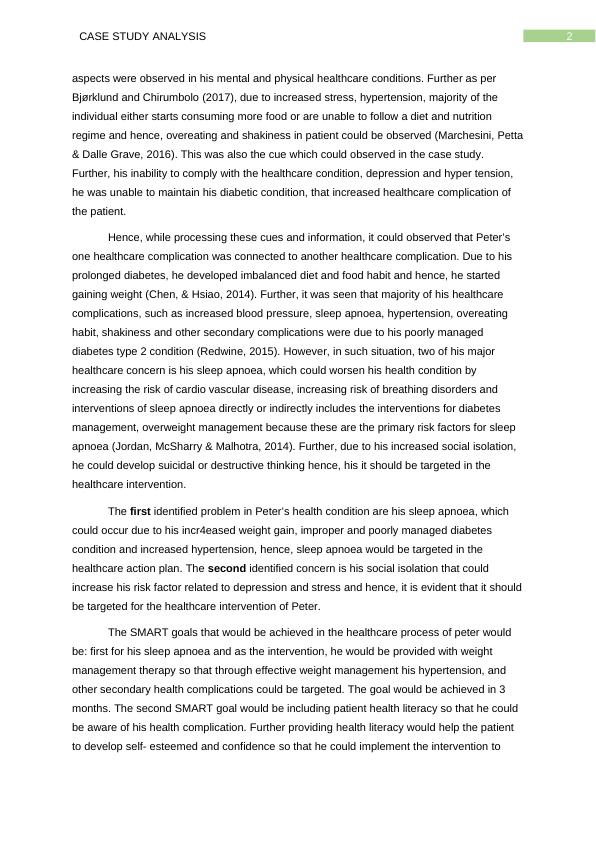Prioritization of Care for Patients with Chronic Health Conditions
Added on 2023-01-16
8 Pages2695 Words43 Views
Running head: CASE STUDY ANALYSIS
CASE STUDY ANALYSIS
Name of the student
Name of the university
Author note
CASE STUDY ANALYSIS
Name of the student
Name of the university
Author note

1CASE STUDY ANALYSIS
Prioritization of care is an effective strategy while caring for patients with chronic
health condition. It includes identification of patient concerns and with the help of patient
developing healthcare goals so that it could be applied in the health and wellbeing
improvement of the patient. However, while prioritization of care for patients suffering from
severe healthcare conditions, healthcare professionals should conduct a complete
interrogation of the healthcare complications so that through the application of interventions
effective care could be provided to the patients and favourable outcome could be achieved
(Dalton, Gee & Levett-Jones, 2015).
This section would discuss about the care process of Peter Mitchell (52) who is
suffering from uncontrolled diabetes, extreme obesity and as in his care process, utilization
of Levett- Jones clinical reasoning cycle would be used so that care for his two identified
health complications such as his sleep apnoea and his social isolation related healthcare
complications could be addressed.
As per the clinical reasoning cycle, patient’s healthcare conditions would be
considered so that with proper evidences, his healthcare complications could be targeted. As
per the case study, peter is suffering from diabetes from 9 years and is unable to manage
his diabetes condition. He has left his job due to his extreme weight gain and to resume his
insulin medication, but has acquired an extreme weight gain (145 kg). He is concerned about
his weight gain due to which he has lost his self- confidence and has isolated himself form
the society, affecting his mental health and occurrence of stress and depression. As per
Lorgunpai et al.(2014), patients with prolonged case of diabetes or any illness are prone to
be affected with extreme depression and similar condition were seen in case of Peter.
Further, it was also seen that Peter is a smoker and smokes more than a pack of cigarettes
every day. These are the patient’s current situations that were identified from the case study
and would be focused for the healthcare interventions.
After considering patient’s current situation, it was seen that majority of the
healthcare complications were associated because of his prolonged diabetes type 2 and the
subsequent extreme weight gain due to which he was suffering from depression and other
secondary health conditions. As per the Han and Lean (2016), patients with extreme case of
diabetes and overweight, are prone to be affected with cardiac diseases due to which their
quality of life could decrease their health complication could increase. Further, it was seen
that majority of the people with deformed or unhealthy physical appearance are hesitant to
take part in social events or communicate within society (Halter et al., 2014). Further due to
prolonged illness, they lose their hope of healthcare improvement and leads to stress and
depression (Slavich & Irwin, 2014). Therefore, from the case study of Peter, all these
Prioritization of care is an effective strategy while caring for patients with chronic
health condition. It includes identification of patient concerns and with the help of patient
developing healthcare goals so that it could be applied in the health and wellbeing
improvement of the patient. However, while prioritization of care for patients suffering from
severe healthcare conditions, healthcare professionals should conduct a complete
interrogation of the healthcare complications so that through the application of interventions
effective care could be provided to the patients and favourable outcome could be achieved
(Dalton, Gee & Levett-Jones, 2015).
This section would discuss about the care process of Peter Mitchell (52) who is
suffering from uncontrolled diabetes, extreme obesity and as in his care process, utilization
of Levett- Jones clinical reasoning cycle would be used so that care for his two identified
health complications such as his sleep apnoea and his social isolation related healthcare
complications could be addressed.
As per the clinical reasoning cycle, patient’s healthcare conditions would be
considered so that with proper evidences, his healthcare complications could be targeted. As
per the case study, peter is suffering from diabetes from 9 years and is unable to manage
his diabetes condition. He has left his job due to his extreme weight gain and to resume his
insulin medication, but has acquired an extreme weight gain (145 kg). He is concerned about
his weight gain due to which he has lost his self- confidence and has isolated himself form
the society, affecting his mental health and occurrence of stress and depression. As per
Lorgunpai et al.(2014), patients with prolonged case of diabetes or any illness are prone to
be affected with extreme depression and similar condition were seen in case of Peter.
Further, it was also seen that Peter is a smoker and smokes more than a pack of cigarettes
every day. These are the patient’s current situations that were identified from the case study
and would be focused for the healthcare interventions.
After considering patient’s current situation, it was seen that majority of the
healthcare complications were associated because of his prolonged diabetes type 2 and the
subsequent extreme weight gain due to which he was suffering from depression and other
secondary health conditions. As per the Han and Lean (2016), patients with extreme case of
diabetes and overweight, are prone to be affected with cardiac diseases due to which their
quality of life could decrease their health complication could increase. Further, it was seen
that majority of the people with deformed or unhealthy physical appearance are hesitant to
take part in social events or communicate within society (Halter et al., 2014). Further due to
prolonged illness, they lose their hope of healthcare improvement and leads to stress and
depression (Slavich & Irwin, 2014). Therefore, from the case study of Peter, all these

2CASE STUDY ANALYSIS
aspects were observed in his mental and physical healthcare conditions. Further as per
Bjørklund and Chirumbolo (2017), due to increased stress, hypertension, majority of the
individual either starts consuming more food or are unable to follow a diet and nutrition
regime and hence, overeating and shakiness in patient could be observed (Marchesini, Petta
& Dalle Grave, 2016). This was also the cue which could observed in the case study.
Further, his inability to comply with the healthcare condition, depression and hyper tension,
he was unable to maintain his diabetic condition, that increased healthcare complication of
the patient.
Hence, while processing these cues and information, it could observed that Peter’s
one healthcare complication was connected to another healthcare complication. Due to his
prolonged diabetes, he developed imbalanced diet and food habit and hence, he started
gaining weight (Chen, & Hsiao, 2014). Further, it was seen that majority of his healthcare
complications, such as increased blood pressure, sleep apnoea, hypertension, overeating
habit, shakiness and other secondary complications were due to his poorly managed
diabetes type 2 condition (Redwine, 2015). However, in such situation, two of his major
healthcare concern is his sleep apnoea, which could worsen his health condition by
increasing the risk of cardio vascular disease, increasing risk of breathing disorders and
interventions of sleep apnoea directly or indirectly includes the interventions for diabetes
management, overweight management because these are the primary risk factors for sleep
apnoea (Jordan, McSharry & Malhotra, 2014). Further, due to his increased social isolation,
he could develop suicidal or destructive thinking hence, his it should be targeted in the
healthcare intervention.
The first identified problem in Peter’s health condition are his sleep apnoea, which
could occur due to his incr4eased weight gain, improper and poorly managed diabetes
condition and increased hypertension, hence, sleep apnoea would be targeted in the
healthcare action plan. The second identified concern is his social isolation that could
increase his risk factor related to depression and stress and hence, it is evident that it should
be targeted for the healthcare intervention of Peter.
The SMART goals that would be achieved in the healthcare process of peter would
be: first for his sleep apnoea and as the intervention, he would be provided with weight
management therapy so that through effective weight management his hypertension, and
other secondary health complications could be targeted. The goal would be achieved in 3
months. The second SMART goal would be including patient health literacy so that he could
be aware of his health complication. Further providing health literacy would help the patient
to develop self- esteemed and confidence so that he could implement the intervention to
aspects were observed in his mental and physical healthcare conditions. Further as per
Bjørklund and Chirumbolo (2017), due to increased stress, hypertension, majority of the
individual either starts consuming more food or are unable to follow a diet and nutrition
regime and hence, overeating and shakiness in patient could be observed (Marchesini, Petta
& Dalle Grave, 2016). This was also the cue which could observed in the case study.
Further, his inability to comply with the healthcare condition, depression and hyper tension,
he was unable to maintain his diabetic condition, that increased healthcare complication of
the patient.
Hence, while processing these cues and information, it could observed that Peter’s
one healthcare complication was connected to another healthcare complication. Due to his
prolonged diabetes, he developed imbalanced diet and food habit and hence, he started
gaining weight (Chen, & Hsiao, 2014). Further, it was seen that majority of his healthcare
complications, such as increased blood pressure, sleep apnoea, hypertension, overeating
habit, shakiness and other secondary complications were due to his poorly managed
diabetes type 2 condition (Redwine, 2015). However, in such situation, two of his major
healthcare concern is his sleep apnoea, which could worsen his health condition by
increasing the risk of cardio vascular disease, increasing risk of breathing disorders and
interventions of sleep apnoea directly or indirectly includes the interventions for diabetes
management, overweight management because these are the primary risk factors for sleep
apnoea (Jordan, McSharry & Malhotra, 2014). Further, due to his increased social isolation,
he could develop suicidal or destructive thinking hence, his it should be targeted in the
healthcare intervention.
The first identified problem in Peter’s health condition are his sleep apnoea, which
could occur due to his incr4eased weight gain, improper and poorly managed diabetes
condition and increased hypertension, hence, sleep apnoea would be targeted in the
healthcare action plan. The second identified concern is his social isolation that could
increase his risk factor related to depression and stress and hence, it is evident that it should
be targeted for the healthcare intervention of Peter.
The SMART goals that would be achieved in the healthcare process of peter would
be: first for his sleep apnoea and as the intervention, he would be provided with weight
management therapy so that through effective weight management his hypertension, and
other secondary health complications could be targeted. The goal would be achieved in 3
months. The second SMART goal would be including patient health literacy so that he could
be aware of his health complication. Further providing health literacy would help the patient
to develop self- esteemed and confidence so that he could implement the intervention to

End of preview
Want to access all the pages? Upload your documents or become a member.
Related Documents
Case Study Analysis: Peter Mitchelllg...
|7
|2692
|37
Case Study Analysis: Nursing Priorities for Peter Mitchelllg...
|9
|2829
|91
Case Study on Peter Mitchelllg...
|7
|2527
|153
Levett-Jones Clinical Reasoning Cycle: Case Study Analysislg...
|8
|3125
|78
Nursing Assignment: Case Study Analysislg...
|7
|2321
|309
Clinical Reasoning Cycle Case Study Analysislg...
|8
|2456
|261
